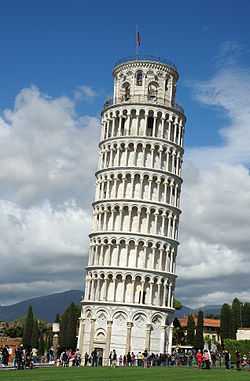Galileo's Leaning Tower of Pisa experiment
According to a biography by Galileo's pupil Vincenzo Viviani, in 1589 the Italian scientist Galileo Galilei had dropped two balls of different masses from the Leaning Tower of Pisa to demonstrate that their time of descent was independent of their mass.[1]:19–21 Via this method, he supposedly discovered that the objects fell with the same acceleration, proving his prediction true, while at the same time disproving Aristotle's theory of gravity (which states that objects fall at speed relative to their mass). At the time when Viviani asserts that the experiment took place, Galileo had not yet formulated the final version of his law of free fall. He had, however, formulated an earlier version which predicted that bodies of the same material falling through the same medium would fall at the same speed.[1]:20 This was contrary to what Aristotle had taught: that heavy objects fall faster than lighter ones, in direct proportion to weight.[1]:9[2] While this story has been retold in popular accounts, there is no account by Galileo himself of such an experiment, and it is accepted by most historians that it was a thought experiment which did not actually take place.[3][4] An exception is Drake, who argues that it took place, more or less as Viviani described it, as a demonstration for students.[1]:19–21, 414–416
Galileo arrived at his hypothesis by a famous thought experiment outlined in his book On Motion.[5] Imagine two objects, one light and one heavier than the other one, are connected to each other by a string. Drop this system of objects from the top of a tower. If we assume heavier objects do indeed fall faster than lighter ones (and conversely, lighter objects fall slower), the string will soon pull taut as the lighter object retards the fall of the heavier object. But the system considered as a whole is heavier than the heavy object alone, and therefore should fall faster. This contradiction leads one to conclude the assumption is false.
See also
- Terminal velocity - an object dropped through air from a sufficient height will reach a steady speed, called the terminal velocity, when the aerodynamic drag force pushing up on the body balances the gravitational force (weight) pulling the body down
- Nordtvedt effect
Notes
- ↑ 1.0 1.1 1.2 1.3 Drake, Stillman (2003). Galileo at work : his scientific biography (Facsim. ed.). Mineola (N.Y.): Dover publ. ISBN 9780486495422.
- ↑ Sharratt, M. (1994). Galileo: Decisive Innovator. Cambridge University Press. p. 31. ISBN 0-521-56671-1.
- ↑ Groleau, R. (July 2002). "Galileo's Battle for the Heavens".
- ↑ Ball, P. (30 June 2005). "Science history: Setting the record straight". The Hindu.
- ↑ Van Helden, Albert (1995). "On Motion". The Galileo Project. Retrieved 16 October 2013.
Further reading
- Adler, Carl G. (1978). "Galileo and the Tower of Pisa experiment". American Journal of Physics 46 (3): 199. Bibcode:1978AmJPh..46..199A. doi:10.1119/1.11165.
- Crease, Robert P. (2006). "The legend of the leaning tower". In Hall, Linley Erin. The laws of motion : an anthology of current thought. Reprint of an article in Physics World", February 2003. (1st ed.). New York: Rosen Pub. Group. pp. 8–14. ISBN 9781404204089.
- Segre, Michael (1989). "Galileo, Viviani and the tower of Pisa". Studies in History and Philosophy of Science Part A 20 (4): 435–451. doi:10.1016/0039-3681(89)90018-6.
External links
| ||||||||||||||

